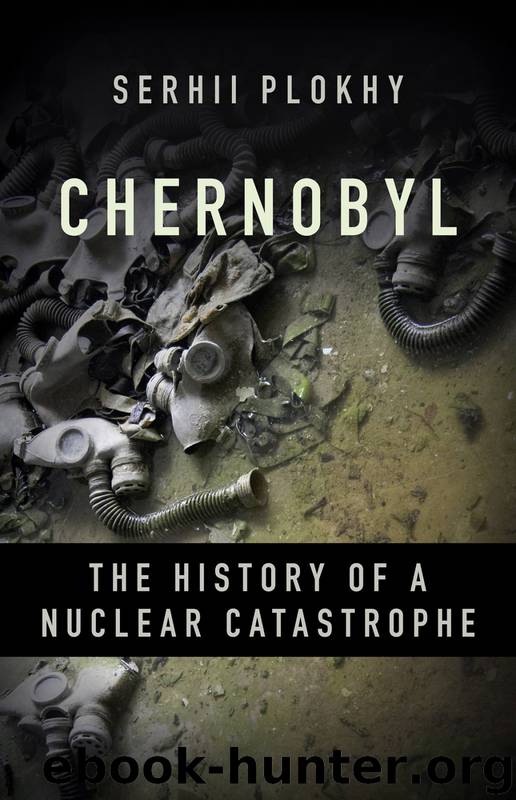Chernobyl by Serhii Plokhy

Author:Serhii Plokhy
Language: eng
Format: mobi, epub, azw3
Publisher: Basic Books
Published: 2018-05-15T00:00:00+00:00
GORBACHEV AND his advisers were at a loss. The measures already taken were no longer working. Water pumped into the reactor during the first hours after the accident had flooded its lower levels, increasing the danger of a much more powerful explosion if the reactor disintegrated completely or burned down to its foundations. Many now believed that attempting to seal the reactor with sand and lead had contributed to a rise in temperature within the reactor, which also increased the possibility of an explosion. Shcherbina had been trying one method after another, hoping that something would work, but so far nothing had proved effective. He had exhausted not only all options at his disposal but also the amount of time he could stay in the Chernobyl zone without jeopardizing his health even further. He was ordered to stay in Moscow and undergo medical treatment.
The torch of chief troubleshooter at Chernobyl was passed from Shcherbina to Ivan Silaev, the gray-haired fifty-five-year-old deputy head of the Soviet government and future leader of the Russian government who, together with Boris Yeltsin, would organize the defense of the Russian parliament against coup leaders in August 1991. Calm, confident, and efficient, Silaev replaced Shcherbina as interim head of the government commission on May 4. But if top managers such as Boris Shcherbina were replaceable, scientists were not. Silaev was badly in need of scientific advice and wanted Legasov back at his side. Legasov was asked to return to Chernobyl after spending only a few hours in the capital.6
Silaev wanted to reduce the probability of a new explosion by removing radioactive water from beneath Unit 4. It was a gruesome reminder of the first day of the catastrophe, when the operators had poured water on the reactor in the hope of preventing its destruction, which had already occurred. Once again, firefighters were assigned to the front line, this time with the task of using their equipment to drain water from the basement. Altogether there were close to 20,000 tonnes of radioactive water underneath the reactor, which was rapidly heating up. The scientists endorsed this measure. “We were afraid that some of the melted fuel would get in there and produce so much steam as to cause additional radioactivity outside,” recalled Valerii Legasov.7
The only way to accomplish the task was to penetrate the flooded underground corridors and open the valves. “It was quite difficult to approach those bubbler pools because the corridors alongside had been filled with water from the moment they tried to cool the reactor with water,” remembered Legasov. “The water level and its radioactivity were high: at particular times and in particular places the level of radioactivity in the water reached one curie per liter.” It was a suicide mission, and Silaev fully understood that. It was then that he decided to save the situation by providing capitalist incentives. With the approval of the political leadership in Moscow, he offered financial bonuses to the divers who agreed to do the dangerous work, including free cars and apartments for them or their families.
Download
This site does not store any files on its server. We only index and link to content provided by other sites. Please contact the content providers to delete copyright contents if any and email us, we'll remove relevant links or contents immediately.
| Automotive | Engineering |
| Transportation |
Whiskies Galore by Ian Buxton(40294)
Introduction to Aircraft Design (Cambridge Aerospace Series) by John P. Fielding(32329)
Small Unmanned Fixed-wing Aircraft Design by Andrew J. Keane Andras Sobester James P. Scanlan & András Sóbester & James P. Scanlan(32135)
Craft Beer for the Homebrewer by Michael Agnew(17439)
Turbulence by E. J. Noyes(7032)
The Complete Stick Figure Physics Tutorials by Allen Sarah(6631)
Kaplan MCAT General Chemistry Review by Kaplan(6044)
The Thirst by Nesbo Jo(5778)
Bad Blood by John Carreyrou(5761)
Learning SQL by Alan Beaulieu(5399)
Weapons of Math Destruction by Cathy O'Neil(5029)
Man-made Catastrophes and Risk Information Concealment by Dmitry Chernov & Didier Sornette(4728)
iGen by Jean M. Twenge(4693)
Digital Minimalism by Cal Newport;(4511)
Life 3.0: Being Human in the Age of Artificial Intelligence by Tegmark Max(4492)
Audition by Ryu Murakami(4091)
1,001 ASVAB Practice Questions For Dummies by Powers Rod(4034)
Electronic Devices & Circuits by Jacob Millman & Christos C. Halkias(4019)
Pale Blue Dot by Carl Sagan(3995)
